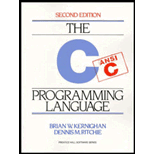
C Programming Language
2nd Edition
ISBN: 9780131103627
Author: Brian W. Kernighan, Dennis M. Ritchie, Dennis Ritchie
Publisher: Prentice Hall
expand_more
expand_more
format_list_bulleted
Question
Chapter 2, Problem 1E
Program Plan Intro
- Initialize the header files and main() function.
- To write the statements for printing the ranges of data types int, long, char, short, char, signed, and unsigned using the header file limits.h.
- Use the printf() statement to print all these.
Summary Introduction- The program prints the range of data types int, long, char, short, char, signed, and unsigned.
Program Description- The purpose of the program is toprint the range of data types int, long, char, short, char, signed, and unsigned.
Expert Solution & Answer
Explanation of Solution
Test Program:
/*
Program: The program to display the range of data types.
*/
#include <stdio.h>
#include <limits.h>
intmain()
{
printf("bits: %d\n", CHAR_BIT);
printf("unsigned char max: %d\n", UCHAR_MAX);
printf("char max: %d\n", CHAR_MAX);
printf("char min: %d\n", CHAR_MIN);
printf("\n");
printf("unsigned int max: %u\n", UINT_MAX);
printf("int min: %d\n",INT_MIN);
printf("int max: %d\n",INT_MAX);
printf("\n");
printf("unsigned short int max: %u\n", USHRT_MAX);
printf("short int min: %d\n", SHRT_MIN);
printf("short int max: %d\n", SHRT_MAX);
printf("\n");
printf("unsigned long int max: %lu\n", ULONG_MAX);
printf("long int min: %ld\n",LONG_MIN);
printf("long int max: %ld\n",LONG_MAX);
printf("\n");
return0;
}
Sample Output -
bits: 8
unsigned char max: 255
char max: 127
char min: -128
unsigned int max: 4294967295
int min: -2147483648
int max: 2147483647
unsigned short int max: 65535
short int min: -32768
short int max: 32767
unsigned long int max: 4294967295
long int min: -2147483648
long int max: 2147483647
Want to see more full solutions like this?
Subscribe now to access step-by-step solutions to millions of textbook problems written by subject matter experts!
Students have asked these similar questions
Using R language
using r language
using r language
Chapter 2 Solutions
C Programming Language
Ch. 2 - Prob. 1ECh. 2 - Write a loop equivalent to the for loop above...Ch. 2 - Write the function htoi(s), which converts a suing...Ch. 2 - Write an alternate version of squeeze(s1,s2) that...Ch. 2 - Prob. 5ECh. 2 - Prob. 6ECh. 2 - Prob. 7ECh. 2 - Prob. 8ECh. 2 - Prob. 9ECh. 2 - Rewrite the function lower, which converts upper...
Knowledge Booster
Similar questions
- I need help in explaining how I can demonstrate how the Laplace & Inverse transformations behaves in MATLAB transformation (ex: LIke in graph or something else)arrow_forwardYou have made the Web solution with Node.js. please let me know what problems and benefits I would experience while making the Web solution here, as compared to any other Web solution you have developed in the past. what problems and benefits/things to keep in mind as someone just learningarrow_forwardPHP is the server-side scripting language. MySQL is used with PHP to store all the data. EXPLAIN in details how to install and run the PHP/MySQL on your computer. List the issues and challenges I may encounter while making this set-up? why I asked: I currently have issues logging into http://localhost/phpmyadmin/ and I tried using the command prompt in administrator to reset the password but I got the error LOCALHOST PORT not found.arrow_forward
arrow_back_ios
SEE MORE QUESTIONS
arrow_forward_ios
Recommended textbooks for you
 C++ for Engineers and ScientistsComputer ScienceISBN:9781133187844Author:Bronson, Gary J.Publisher:Course Technology Ptr
C++ for Engineers and ScientistsComputer ScienceISBN:9781133187844Author:Bronson, Gary J.Publisher:Course Technology Ptr C++ Programming: From Problem Analysis to Program...Computer ScienceISBN:9781337102087Author:D. S. MalikPublisher:Cengage Learning
C++ Programming: From Problem Analysis to Program...Computer ScienceISBN:9781337102087Author:D. S. MalikPublisher:Cengage Learning Microsoft Visual C#Computer ScienceISBN:9781337102100Author:Joyce, Farrell.Publisher:Cengage Learning,
Microsoft Visual C#Computer ScienceISBN:9781337102100Author:Joyce, Farrell.Publisher:Cengage Learning, EBK JAVA PROGRAMMINGComputer ScienceISBN:9781337671385Author:FARRELLPublisher:CENGAGE LEARNING - CONSIGNMENT
EBK JAVA PROGRAMMINGComputer ScienceISBN:9781337671385Author:FARRELLPublisher:CENGAGE LEARNING - CONSIGNMENT

C++ for Engineers and Scientists
Computer Science
ISBN:9781133187844
Author:Bronson, Gary J.
Publisher:Course Technology Ptr

C++ Programming: From Problem Analysis to Program...
Computer Science
ISBN:9781337102087
Author:D. S. Malik
Publisher:Cengage Learning

Microsoft Visual C#
Computer Science
ISBN:9781337102100
Author:Joyce, Farrell.
Publisher:Cengage Learning,

EBK JAVA PROGRAMMING
Computer Science
ISBN:9781337671385
Author:FARRELL
Publisher:CENGAGE LEARNING - CONSIGNMENT